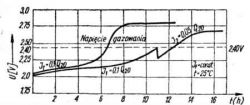zybex wrote: My nephew has a Kukla charger and he does not complain and often charges the batteries, ...
I had this 15A device at the turn of 2018/2019, which I remember from those experiences.
The device delivered no more than 10 A, so the 100 Ah battery should charge 10-12-14 hours, nothing after setting the knob to max. that is, the 10A charger was only on strike, unless the overheating protection of the charger worked.
I set the charger knob to less, something about 50-70% of the power, but then the charging current amps went to about 4-5A, which is half of the previous charging current, which translated into the fact that the 100 Ah battery was charged for 60 hours and the other battery was 70 or 74 Ah 48 hours !!!!.
The charger gives a voltage of 16V in the middle of the charging time, it was hard for me to accurately capture the battery every 2-4 hours, I do not have professional devices.
It also made the electrolyte density but the time of this process is shocking.
Yes, I will not buy it, unless Mr. Kukla has improved the current to the 10A and the charger protections will not turn it off.




